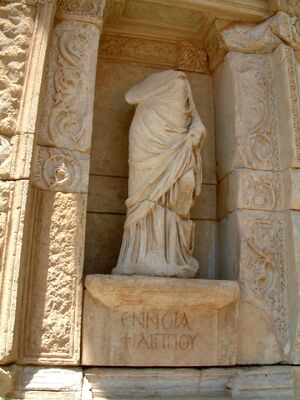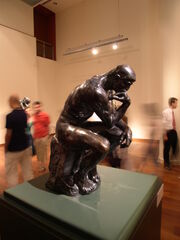Assessment |
Biopsychology |
Comparative |
Cognitive |
Developmental |
Language |
Individual differences |
Personality |
Philosophy |
Social |
Methods |
Statistics |
Clinical |
Educational |
Industrial |
Professional items |
World psychology |
Cognitive Psychology: Attention · Decision making · Learning · Judgement · Memory · Motivation · Perception · Reasoning · Thinking - Cognitive processes Cognition - Outline Index

Personification of thought (Greek Εννοια) in Celsus Library in Ephesos, Turkey
Thought or thinking is a mental process which allows beings to model the world, and so to deal with it effectively according to their goals, plans, ends and desires. Words referring to similar concepts and processes include cognition, sentience, consciousness, idea, and imagination.
Thinking involves the deeply cereberal manipulation of information, as when we form concepts, engage in problem solving, reason and make decisions. Thinking is a higher cognitive function and the analysis of thinking processes is part of cognitive psychology.
Basic process
The basic mechanics of the human mind reflect a process of pattern matching or rather recognition. In a "moment of reflection", new situations and new experiences are judged against recalled ones and judgements are made. In order to make these judgements, the intellect maintains present experience and sorts relevant past experience. It does this while keeping present and past experience distinct and separate. The intellect can mix, match, merge, sift, and sort concepts, perceptions, and experience. This process is called reasoning. Logic is the science of reasoning. The awareness of this process of reasoning is access consciousness (see philosopher Ned Block).
Conceptualization
Thinking can be modeled by a field (like a mathematical representation of an electro-magnetic field, but with each point in the field a point of consciousness). Patterns are formed and judgements are made within the field. Some philosophers (panpsychists/panexperientialists - see wikibook on consciousness) believe the entire field is conscious in and of itself, a consciousness field. They say consciousness creates thinking, thinking and other brain processes do not create consciousness. Other scientists (for example Bernard Baars) think of it as a workspace. Some philosophers (for example Thomas Nagel) have said they do not have a clue as to how we are aware of our thinking.
A thought can be said to be whatever arises in the dualistic mind. A dualistic mind is one in which the one from which the thought arises considers himself to be separate from other forms. A thought may be an idea, an image, a sound, a smell, a touch or even an emotional feeling that arises from the brain.

The Thinker by Rodin, Sakıp Sabancı Museum, Istanbul.
Aids to thinking
- Use of models, symbols, diagrams and pictures.
- Use of abstraction to simplify the effort of thinking.
- Use of metasyntactic variables to simplify the effort of naming.
- Use of iteration and recursion to converge on a concept.
- Limitation of attention to aid concentration and focus on a concept. Use of peace and quiet to aid concentration.
- Goal setting and goal revision. Simply letting the concept percolate in the subconscious, and waiting for the concept to re-surface.
- Talking with like-minded people. Resorting to communication with others, if this is allowed.
- Working backward from the goal.
- Desire for learning.
Pitfalls
- Fads.
- Self-delusions: inability to confront relevant issues (roadblocks).
See also
- Abstraction
- Autistic thinking
- Divergent thinking
- List of basic thinking-related topics
- Lists of thinking-related topics
- Logical thinking
- Magical thinking
- Language of thought
- Language and thought
- Intrapersonal communication
- Reasoning
- Stream of consciousness (psychology)
- Train of thought
References
- Eric Baum (2004). What is Thought, Chapter Two: The Mind is a Computer Program. MIT Press. ISBN 0-262-02548-5
| This page uses Creative Commons Licensed content from Wikipedia (view authors). |